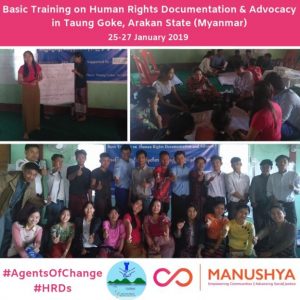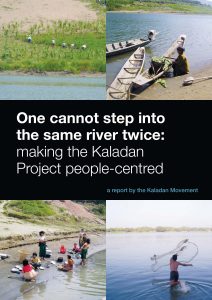Rivers in Arakan have played a fundamental role in the lives, history and culture of the Arakanese people and their civilisation for thousands of years.The waterways provide irrigation, potable water, fish supplies and cheap transportation, supporting millions of livelihoods all over Arakan. Water from the rivers is a basic natural resource, essential for various human activities. Therefore, their banks have been attracting settlers ever since the ancient times of Arakan. The largest of these settlements have now become the centuries-old cities locally and internationally known as Dhanyawaddy, Vesali, Laymro and Mrauk-U.
Although, rivers in Arakan have traditionally been mainly used for irrigation, transportation, fishing and navigation, nowadays their potential for the generation of hydropower is of greater significance to Burma’s ruling military junta. One of the best-known facts about Arakan’s rivers is the extremely fertile soil they produce, the key to the fast development of the region’s ancient cities. The fertile soil in these areas is contributed to by the annual floods during the rainy season, when the rivers overflow onto their banks. In these flooded areas, agricultural farming, fish breeding and shrimp/prawn farming are widely exercised and practised by the entire Arakanese population.
Arakan’s most complex river system is made up of the state’s four major rivers: the Naff, Mayu, Kaladan and Laymro and their numerous tributaries. These rivers flow through the Northern part of Arakan before pouring their waters into the Bay of Bengal. The Kaladan, Laymro and Mayu rivers all meet the sea near Site-tway, the state capital. Among these four main rivers the Kaladan and Laymro have been the most useful and important to the people throughout the civilisation’s history. More than two thirds of the entire State’s agricultural land is situated the Kaladan and Laymro rivers’ valleys and plains, where Site-tway, Ponnagywan, Kyauktaw, Mrauk-U, Pauktaw, Munbra and Rathedaung townships are located.
Arakan State’s economy relies heavily on the state’s natural resources. Like in many other parts of Burma, both small and large businesses in the area depend on the trade of products from agriculture and fishing. Experiencing no particular economical improvements in either sector because of the military junta’s longtime economic mismanagement of the country, a large percentage of Arakan State’s population live in sever poverty. According to UNDP statistics from 2007, 38 % of the state’s population are living below the poverty (perhaps a link here to UN description of the PL). This figure is even higher, at 41 % when looking just at Arakan’s rural areas, where people are even more dependant on the agricultural and fishing sectors.
For the majority of Arakan’s population, rivers are the primary means of transport. This is mainly because the few roads in the region are in terrible condition. For this purpose, waterways serve as a lifeline for rural people to get access to needed goods and markets. In Arakan state, boats travel up and down the rivers selling and trading fire wood, bamboo as building material, and fish and farming products such as rice, fruits and vegetables.
The Importance of rivers in Arakan
Rivers in Arakan have played a fundamental role in the lives, history and culture of the Arakanese people and their civilisation for thousands of years. These waterways provide irrigation, potable water, fish stocks and cheap transportation, supporting millions of livelihoods all over Arakan. Water from the rivers is a basic natural resource, essential for various human activities; Arakan’s rivers’ banks have accordingly attracted settlers since antiquity. The largest of these settlements became regionally and internationally known metropolitan centres of commerce and culture whose fame has survived over centuries; the most famous of these cities include Dhanyawaddy, Vesali, Laymro and Mrauk-U.
Traditionally, rivers in Arakan have been used primarily for irrigation, transportation, fishing and navigation; however, at present their potential for hydropower generation is of greater significance to Burma’s ruling military junta. That Arakan’s rivers produce and support extremely fertile soil is widely known. Indeed, this rich soil was central to the development and prosperity of Arakan’s ancient cities. The annual floods of the rainy season further enrich the soil, as the rivers overflow their banks and deposit nutrient-rich silt over adjacent land. In these regularly-flooded areas agriculture, as well as fish and shrimp/prawn farming are widely practised by the majority of the population. For many, these activities constitute their sole sources of income or, in many cases, subsistence.
Arakan’s most complex river system is made up of the state’s four major rivers: the Naff, Mayu, Kaladan and Laymro, plus their numerous tributaries. These rivers flow through the Northern part of Arakan State before emptying into the Bay of Bengal. The Kaladan, Laymro and Mayu all meet the sea near Site-tway, the state capital. Of these four main rivers the Kaladan and Laymro have been the most useful and important to the people throughout the history of Arakan. More than two-thirds of the entire State’s agricultural land is found in the river valleys and plains of the Kaladan and Laymro, as well as Site-tway, Ponnagywan, Kyauktaw, Mrauk-U, Pauktaw, Munbra and Rathedaung townships.
Arakan State’s economy relies heavily on natural resources. As in many other parts of Burma, both small and large businesses in the area depend on trade in products from agriculture and fishing. A large percentage of Arakan State’s population live in severe poverty because no particular economical improvements have been experience in either the agriculture or fishing sectors for decades, thanks to the military junta’s gross economic mismanagement of the country. According to UNDP statistics from 2007, 38 % of the state’s population are living below the poverty line. This figure is even higher, at 41 %, if one looks just at Arakan’s rural areas, where people are even more dependent on the agricultural and fishing sectors.
For the majority of Arakan’s population, rivers are the primary means of transport. This is mainly because the few roads in the region are in terrible condition. Waterways therefore frequently serve as a lifeline for rural people to get access to essential goods and markets. In Arakan state, boats travel up and down the rivers selling and trading fire wood, bamboo as building material, and fish and farming products such as rice, fruits and vegetables.



